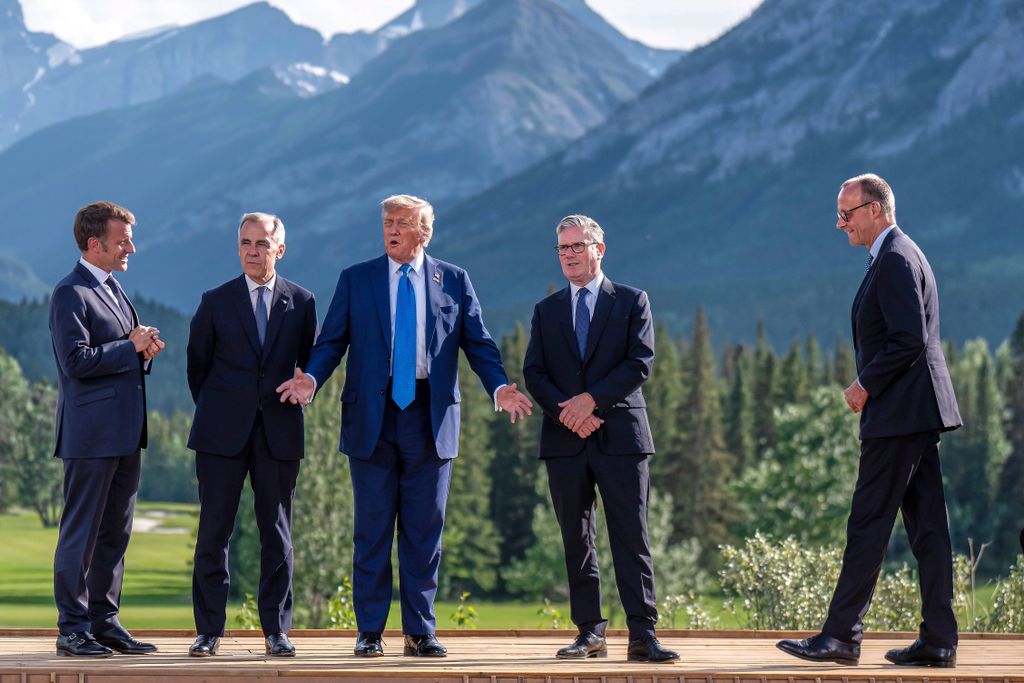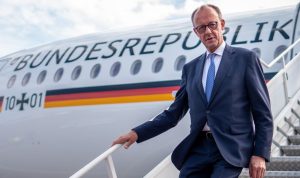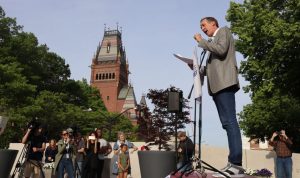G-7 summit participants Emmanuel Macron, Mark Carney, Donald Trump, Keir Starmer and Friedrich Merz in Canada.
Michael Kappeler / dts Nachrichtenagentur / IMAGO
Is he coming? Or is he not coming? There’s not much time left until the summit of NATO member states in The Hague, but officials in the Brussels headquarters of the military alliance were still not entirely sure last week if U.S. President Donald Trump was going to show up or not. NATO diplomats and military leaders, though, have a fair amount of experience when it comes to accessing sensitive information, and they came up with some creative snooping strategies to figure out if Trump was going to make the trip: They began keeping close track of how many hotel rooms the U.S. delegation had booked in The Hague. Fewer than 1,000, say insiders, would be a warning that Trump might skip the meeting.
Doubts about the reliability of the NATO hotel-bed index are warranted. But it does reveal quite a bit about the alliance’s current state – and about the uncertainty and friction that characterizes the trans-Atlantic partnership in the Trump era.
The article you are reading originally appeared in German in issue 26/2025 (June 21st, 2025) of DER SPIEGEL.
The approaching NATO summit will be a key indicator for the future of the northern Atlantic defensive alliance. Even diplomats are saying as much, a group that at times plays down even public bickering as an "open exchange of views.” With the founding of NATO 76 years ago, the Americans threw their support behind peace, freedom and security in Europe. But is that support still there in Trump’s America? Or is the U.S. turning away? Recently, the U.S. president has left the impression that he would prefer to do business with Russian strongman Vladimir Putin than stand up for his allies.
The alliance has likely never before faced so much pressure from the outside and from the inside.
Israel’s attack on the Iranian nuclear program, joined by the U.S. over the weekend, could escalate into a larger Middle Eastern conflict, directly bordering the NATO area. Furthermore, Putin is continuing to push his war in Ukraine with ever more offensives. And according to the Bundesnachrichtendienst (BND), Germany’s foreign intelligence service, Moscow could be equipped for a large offensive against NATO by the end of the decade. And Putin might be tempted to test the alliance’s solidarity before that.
Air defense above Tel Aviv on June 18. The war in the Middle East is overshadowing the NATO summit.
The collective defense clause is the central feature of the NATO alliance, laid out in Article 5 of the North Atlantic Treaty. An armed attack on one alliance member "shall be considered an attack against them all,” reads the NATO foundational document. Each member will be defended by all the rest. But even during his first term in office, Trump threatened to pull the U.S. out of the alliance. He attached a price tag to the protection guarantee, making it conditional. All NATO members, he insisted back then, must meet the target of spending the equivalent of 2 percent of GDP on defense. Now, he is demanding 5 percent, a number pulled out of thin air. He has even said that the Russians could "do whatever the hell they want” to any NATO member state that doesn’t reach that level of defense spending.
Mark Rutte, the secretary general of NATO, has repeatedly spoken of "the strongest defensive alliance in world history.” But its credibility has been tarnished. Rutte is hoping that the summit in The Hague will send a clear signal of unity and determination, a strong message of deterrence to Putin. And because sending that message depends on Trump more than anyone else, Rutte has tailored the summit entirely to the U.S. president.
Rutte, 58, doesn’t like surprises. In his private life, he stoically sticks to his habits, always spending his vacations in the same places with the same people, for decades, as could be read in a biography that was published last year. Rutte is the kind of person who always wants to have everything under control, at all times. It is his first summit as the head of NATO, with the former prime minister of the Netherlands taking over the top spot in the alliance in October 2024. Soon thereafter, he began making meticulous preparations.
Even before Trump was elected to a second term in office in January, Rutte paid him a visit in Mar-a-Lago, Florida. Two official visits to the White House have followed. In the Oval Office, Rutte flattered the president and praised his strong leadership. When Trump started blathering about the U.S. annexing Greenland, Rutte merely grinned, declining to contradict the U.S. president.
NATO Secretary-General Mark Rutte with Trump in the Oval Office.
Internally, the secretary general sent the message that the NATO summit must be geared to the preferences and idiosyncrasies of the visitor from Washington. Anything that might put Trump in a bad mood must be avoided. Instead of the long meetings with numerous prepared statements that have become standard, Rutte said he wanted a "splash” – something shorter and with more impact. Something for which the president could take credit – and which wouldn’t strain his attention span.
Rutte and his team had placed great hopes in the G-7 summit, with the heads of state and government from the world’s seven largest economies meeting last week in Canada. At previous G-7 meetings, ties and suitcoats have been set aside, creating a more intimate, open atmosphere for the talks – and leaders could even establish personal relationships. The format could have been the perfect, soft launch for the NATO summit in The Hague. But Rutte’s hopes would go unfulfilled.
The G-7 gathering in Canada became a summit of uncertainty.
Ukrainian President Volodymyr Zelenskyy flew more than 8,000 kilometers to the site of the summit, the Rocky Mountain resort town of Kananaskis, arriving on Tuesday. Zelenskyy had been hoping to meet with Trump that morning, but the U.S. president abruptly left the summit on the previous evening. The war in the Middle East is clearly more important to him than the war in Ukraine. He is concerned about the Iranian missiles, less so about the Russian.
The horror of the previous night was writ across Zelenskyy’s face. A pale Ukrainian president stood in his black outfit next to Canadian Prime Minister Mark Carney and spoke about how he had conferred with his government ministers and the commander of Ukraine’s air defenses from the plane. His country, he said, "had a very difficult night.” He noted that Russia had fired 440 drones and 32 missiles at his country overnight, injuring 138 and killing 12. "It is a great tragedy.”
Zelenskyy few 8,000 kilometers to the G-7 summit in Canada only to be stood up by Trump.
Kyiv following Russian strikes on June 17.
Putin had sent a bloody message with one of the worst airstrikes on Ukraine since the beginning of the invasion. And the man who is in the best possible position to help Zelenskyy left before meeting with the Ukrainian leader. In the meeting of G-7 leaders, Carney sat Zelenskyy to his left, right where Trump had been one day earlier.
G-7 leaders had been hoping to use the summit to convince Trump to finally ramp up the pressure on Putin to agree to a ceasefire. But Trump torpedoed those plans with his premature departure. Indeed, the U.S. president’s participation in the summit will primarily be remembered for his demand that Russia be reaccepted to the club.
Rutte watched proceedings from up close, as he, too, was in Canada. Should he have been disappointed with how the G-7 turned out, he didn’t let on. Instead, he announced cheerfully that 31 of 32 NATO member states have agreed to Trump’s 5-percent demand, with only Spain holding out. And, Rutte added, he hoped to get Madrid on board by the following week. The target of his message was clear: Trump.
Spanish Prime Minister Pedro Sánchez, however, has proven to be a hard nut to crack. Last Thursday, a letter he had sent to Rutte became public, in which he wrote that the 5-percent target is "not only unreasonable, but also counterproductive.” He has threatened to vote against the target – which doesn’t make things any easier for Rutte.
The secretary general is hoping for a light-speed summit, with leaders only coming together for a single confidential North Atlantic Council session – and plans call for that session to last no more than two hours, all part of his effort to ensure that things don’t spin out of control. And that meeting, it is clear, will focus on money.
Rutte has prepared a deal that Trump might like. By the end of last week, negotiators had largely reached agreement on the final declaration, one which will be shorter than those from previous summits. The fact that a communiqué will even be issued is considered a success.
The document – just a few paragraphs, really – will primarily convey that message that Europe has got the message. Trump’s desire will be fulfilled. The deal calls for the 5 percent to be divided into categories, with 3.5 percent reserved for classic military expenditures with countries able to use the remaining 1.5 percent on infrastructure, such as roads, bridges and rail lines that can be used for troop transport. Or for cyber-defense. Ultimately, though, Trump’s 5-percent goal will be part of the document.
Ukrainian President Volodymyr Zelenskyy(second from left) at the G-7 summit.
That means that Germany, which budgeted 52 billion euros for its military in 2024, will have to increase defense spending to 150 billion euros per year to meet the 3.5-percent mark. German Defense Minister Boris Pistorius intends to increase spending by 0.2 percent per year.
As yet, no deadline for reaching the new target has been established. Rutte has proposed 2032, too late from the perspective of the Baltic states and Poland, which are demanding 2030. Otherwise, we’ll have to "start learning Russian,” says Lithuanian Defense Minister Dovilė Šakalienė. Italy, by contrast, has demanded a deadline of 2035. The five-year difference makes a large difference in the member-state budgets – but such details are not to disrupt the summit.
Rutte’s diplomats are proud of the fact that they were able to convince Trump’s people to include formulations that used to be self-evident in NATO declarations. In the very first paragraph, the document reaffirms the members' commitment "to the trans-Atlantic bond." The "ironclad commitment" to collective defense is also mentioned, "as enshrined in Article 5." It is even spelled out: "an attack on one is an attack on all."
Should the declaration be passed without changes, it will be a success for Rutte. And a bit of reassurance for the Europeans. For quite some time, diplomats at NATO headquarters were concerned that Trump wanted to prevent any mention of the threat to NATO represented by Russia. Now, however, the document includes the formulation that NATO is "united” in the face of the numerous threats and challenges, "particularly the long-term threat presented to Euro-Atlantic security by Russia.”
When it comes to Ukraine, however, the Europeans will have to be satisfied with less. In 2023, at the summit in the Lithuanian capital of Vilnius, NATO held out the prospect of the country joining the alliance. This time around, the declaration only vaguely states that all allies stand by their commitment to continue supporting Ukraine as best they can – a clear step backwards.
Math tricks with the 5-percent goal? A new, less committed tone when it comes to Ukraine? Why is Berlin going along?
For many years, it was Germany that pushed back against higher defense spending. Now, though, Berlin is trying to take a leadership role. Chancellor Friedrich Merz wants to make the country’s military, the Bundeswehr, into the "the strongest conventional army in Europe.” Lars Klingbeil, the SPD head who is also vice chancellor and finance minister, has also expressed his support of the 3.5-percent target.
Germany has shifted its focus recently and intends to take a leading role in European military capabilities.
Berlin has emphasized that its aim is not that of satisfying Trump’s desires. At least not exclusively. It is, the government notes, very much in Germany’s interest to ensure that the Americans remain part of the alliance with a footprint in Europe, since the Europeans lack vital military capabilities, from air transport and surveillance to air defense. First and foremost, however, says Berlin, defense spending must increase to make up for the shortcomings of recent years and ensure the country’s ability to defend itself and its allies. Berlin is convinced that NATO’s credibility and its ability to act as a deterrence to Russia depends on its military capabilities. And that, German leaders believe, is where the Europeans – and especially Germany – are called upon.
Intelligence agency warnings saying that Russia could present a military challenge to NATO as early as 2029 play a big role in the new "Bundeswehr Military Strategy,” which DER SPIEGEL has obtained. Military leaders and experts spent about a year and a half developing the confidential paper, which breaks down the threat situation facing Germany.
Right at the beginning, the paper describes the consistent expansion of Putin’s army, saying that by 2026, it could include 1.5 million troops. Over the years, the paper notes, Russia has "deliberately amassed battlefield experience in Chechnya, Syria and now in Ukraine and further developed its armed forces.” Russia has shifted to a wartime economy, thus increasingly establishing "a military advantage” relative to other militaries in Egypt. The Kremlin is gearing both its industry and command structures "specifically to the requirements of a large-scale conflict with NATO at the end of this decade.”
The tone of the paper grows gloomier from paragraph to paragraph. Putin, it says, is primarily boosting his armed forces in western Russia, "on the border with NATO.” That produces an "existential threat” to Germany that can only be countered "with a vigorous expansion of military and societal capabilities.” The document makes it clear that the strengthening of the Bundeswehr could be Germany’s first political and societal priority in the coming years.
German Defense Minister Boris Pistorius is seeking to boost Germany's military.
For each member state, NATO defines what it must bring to the alliance. It has adjusted its military expectations for the coming years. Defense Minister Pistorius has declined to say precisely what that means for Germany. On the sidelines of a NATO defense ministers meeting, he recently spoke of 50,000 to 60,000 additional active-duty soldiers. Once everything is added up, he says, the additional personnel, the tanks, air defense batteries and warplanes, the result is roughly 3.5 percent of GDP. Consistent with the decision set to be made at the NATO summit.
The meeting, according to Rutte’s plan, is supposed to begin on Tuesday with a dinner, hosted by King Willem-Alexander and Queen Máxima at Huis ten Bosch. Trump enjoys being in the company of royalty and it could put him in a good mood – if he shows up.
Even if everything goes according to Rutte’s plan, the real test for NATO will only come after the summit, say military leaders and diplomats. In the fall, the U.S. will be informing its allies of its "global posture review.” Like every incoming administration, the Trump administration is examining how many soldiers are stationed where and whether changes need to be made.
It seems clear that the U.S. will be reducing its presence in Europe, a development that already got started during the presidency of Trump’s predecessor, Joe Biden, according to top military brass. The situation would become critical if the U.S. opted to move its weapons and air-defense capabilities out of Europe. Still, though, the U.S. has never called its nuclear umbrella into question, say leaders. As such, they say, the removal of American warheads stored in Europe is not at issue.
When it comes to other capabilities, however – including troops, weapons and intelligence expertise – the Europeans believe that the Americans may reduce their engagement. And that could result in security gaps. Pistorius is urging the Europeans to clarify which countries could step in to replace which U.S. capacities. That will be Rutte’s next task. And it is likely to be far more challenging than getting the NATO summit over the finish line without a hitch.









